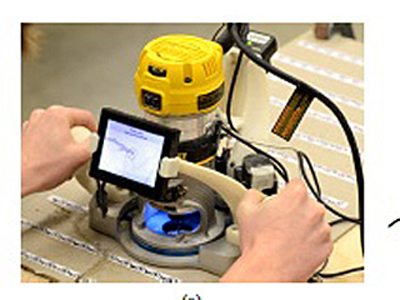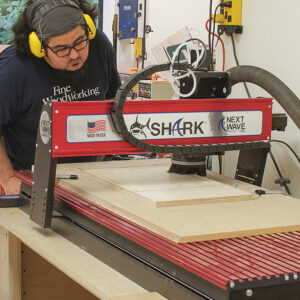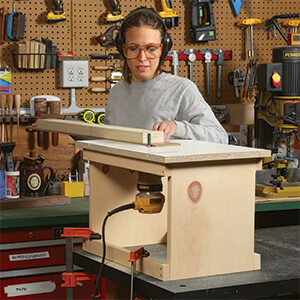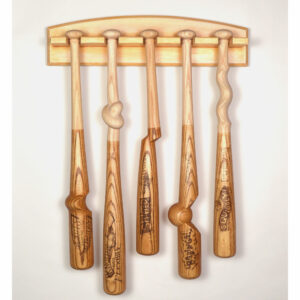I’m an invention geek, and I subscribe to a number of e-Letters that show innovative new products and ideas. Today I received a notice about a student at Massachusetts Institute of Technology (MIT) who just may be at the fore of a CNC revolution for home shops.
Alec Rivers, a PhD student in the Department of Electrical Engineering and Computer Science (EECS), was frustrated by the imprecise results he was getting while building a picture frame using some of his grandfather’s tools. So, with the help of Frédo Durand, an EECS associate professor and member of the Computer Science and Artificial Intelligence Laboratory (CSAIL), and Ilan Moyer, a graduate student in the Department of Mechanical Engineering, he designed and built a handheld CNC-like router guide.
The handheld router guide automatically adjusts the router’s position so that the bit follows a digital plan. All the user has to do is get the bit within 1/4 in. or so of the cutline, and the computer takes over. The system allows you make exact, repeatable patterns that would be useful for cutting recesses for inlay as well as the inlaid parts themselves. It would also be helpful for reproducing identical parts.
This video shows the rig in use. The trio of inventors will unveil the system this week at the Siggraph (organization Special Interest Group on GRAPHics and Interactive Techniques) conference in Los Angeles. The organization is dedicated to “the innovation and application of computer graphics and interactive techniques.”
According to the article, this device will cost much less than the CNC systems currently available, which typically run in the thousands of dollars (though some manufacturers are attempting to make useful, smaller systems for home shops).

With the device, you just have to get the bit within 1/4 in. of the pattern, then the router is automatically adjsted to cut on the line.






















Comments
Hand-held CNC. Interesting oxymoron. Or, would that be a non sequitur? ;-)
Those boys (and girls) at MIT are always coming up with interesting things, some of which aren't too practical. Now, if they had added satellite-style thruster engines to the router . . .
A rocket-powered router. I like that...
"frustrated by the imprecise results he was getting while building a picture frame using some of his grandfather's tools"..... Betcha grandpa didn't get imprecise results!
You gotta love it when the smart kids remember their roots and come up with something that can help the "meat and potatoes" crowd! After all, most of them wouldn't be where they are if someone in their families didn't have hands full of calluses!
Nice work.
You gotta love it when the smart kids remember their roots and come up with something that can help the "meat and potatoes" crowd! After all, most of them wouldn't be where they are if someone in their families didn't have hands full of calluses!
Nice work.
I agree with 'fortville', grandpa did some great work and all of it by hand tools. Also what happened to reducing our carbon footprint? Now for the flipside, you gotta admire the next generation
I'd love to have that screen on all of my routers - couldn't care less about the CNC though.
By the time this becomes widely available, won't it also need a Sawstop sensor?
I don't know about you but my grandpa was a blacksmith and also great woodworker. He used red lead paint which at the time was the "best" you could get, should I use the same paint he used. he was one of the first to use an electric welder in the area. He took great pride in his work and would never hold himself back by not using the latest in tools and machines. If we all held back to "grandpa's" tools would our grandchildren use our tools that were the same as our grandpa's tools. Yes, the better you are with your hand tools the better woodworker you will be but don't limit yourself. Don't we all want the best steel for our cutting edges and not what the average person had generations ago.
GO MIT!
***ROLLING MY EYES***
(How does "carbon footprint" wind up in a discussion about a router?)
I'd rather have a TV monitor so I can comfortably and safely observe the router bit. I'd buy that today if available.
I want one of these. Imagine laying out a complex curve on CAD software and then cutting it in one shot for a template. No sanding no file work, just cut it and use it.
The thing that makes CNC robots great is repeatability and accuracy. You get what you want the same every time. This is an excellent way to get that without the big table and expense. Perfect for the small shop guys making bending templates or shaper templates. Perhaps not for cabriole legs, but when was the last time you made one of those?
Wow!
On the one side, I surely do admire the "tech" component to this video-router setup, to say nothing of the countless hours these three geeks must have spent on it. Wood-dust
I am however reminded of that episode of The Big Bang Theory where the 4 geeks took countless hours to setup an elaborate way to use wireless networking around the world, just to simply turn on their living room light switch.
What a truly elegant solution to a non-existent problem.
Just thinking - when does a woodworker become instead a machinist?
I guess I am gullible, but this seems like a wonderful addition to a router. I know many of you can work within 0.001 inch accuracy, but my old hands arent that good anymore. This gadget seems like a true wonder..
I guess I am gullible, but this seems like a wonderful addition to a router. I know many of you can work within 0.001 inch accuracy, but my old hands arent that good anymore. This gadget seems like a true wonder..
I guess I am gullible, but this seems like a wonderful addition to a router. I know many of you can work within 0.001 inch accuracy, but my old hands arent that good anymore. This gadget seems like a true wonder..
I want one. I already have the router. I'm a graphic designer turned woodworker. This invention will open-up a whole new world of inlays and details for the design oriented woodworker.
Alec, I'd like to help you with your promotional materials. I'm located just west of Boston. lgsmith@graficsmiths.com
I think the system has a great potential. There are a lot of woodworkers that could and would utilize this system if it were made available. Hopefully the price would be well below that of the current CNC table mounted models, thus allowing more people the expand their wood working techniques. Keep up the good work and I hope the editors keep us informed about availability of this in the future.
Keep us posted, Tom. This is one of those gadgets that I'm sure I'll find a use for...like the internet turned out to be.
Useless - you still have to hold it. Why not attach a gps unit to it and just program using coordinates? And it only does flat sheet goods. let's see, my woodworking consists of exactly - yes - 0 use of sheet goods requiring perfect cutouts.
I wonder how he went from wanting to make a picture frame to developing a router as a CNC device? I think he still has not solved his picture frame problem.
btw, more technical discussion available here:
http://www.alecrivers.com/positioncorrectingtools/files/Position-Correcting%20Tools%20for%202D%20Digital%20Fabrication.pdf
He might be smart but he's going to be deaf....no hearing protection
It would have been more useful if it moved itself around the board.
This should have given it capabilities that the gantry type CNC machines can't match at a reasonable cost with no giant machine to suck up shop space.
Perhaps using optical mouse tech and some drive wheels or tracks?
Maybe I should patent that! Maybe I should make one myself, sounds completely doable. Even the software doesn't seem too big.
I believe this is what future power tools will be like. Low cost, minimal manual skill for easy access to beginners, and remote safety.
Notice the multiple carefully placed coordinate tapes that the camera used to
make adjustments to the router position. How long did that take?
Looks like an interesting feedback system between the position detection camera snd the router position platform.
Good Job!
From one Engineer to another.
Pretty neat. I like the fact that it might keep peoples hand in the craft a little longer. I guess everything was the latest greatest at their inception. The first bandsaw must have been thought of as a miracle tool.
Maybe now I can charge more for my handwork and it's flaws?
Great demonstration of engineering skill applied to developing a $500 add-on to a $150 tool - and that doesn't include the PC, software, templates (unless you have the CAD system to create yourself) and grid overlays you'll need to apply to your workpiece in order to perform this operation.
The demo worked fine routing out the pattern in the acryllic material, and would probably be okay working with MDF. But what happens when you're encountering grain patterns and varying degrees of resistance to the bit? The positioning motors could move the router frame instead of the bit and you'd be off your pattern then.
Additionally, I'd be concerned with the reliability of the position motors and mechanism as well. There's a reason gantry type equipment is built with robustness to insure accuracy and repeatability.
The CNC "Shark" type of equipment is a more durable, productive, and practical type of tool for this type of application in my opinion.
Interesting prototype. This being the first iteration of a possibly new product, how long will it be before a Z-axis capability is added. I have one of the small home CNC machines and I love its potential. Getting that potential over to a reality involves a fair bit of twiddling the computer model and "discovering" more engineering shortcomings of the CNC machine itself. After several trial cuts (all 3 dimensional) I finally get something I can use. Being able to take a wood block and trial cut a difficult portion of the carving would be a great time saver. Now it can take up to 18 hours to cut a test piece on a block of pine before I use the "good stuff".
After reading SRMMMM's comment, here's something I can pass along: I do all my computer model designing in SketchUp (free software). I export my completed model in .3DS (3D Studio) format. I import the .3DS model into Blender (more free software) to convert and export it into a format my CNC machine uses. I already had the computer, which I think probably applies to most (if not all) woodworkers interested in this aspect of woodworking.
SketchUp (http://www.sketchup.com/)
Blender (http://www.blender.org/)
No software was harmed or purchased in the formulation of this comment.
Good point on the software aspect IRONARMADILLO and the PC issue may or may not be a big concern depending on how much processing horsepower it needs.
Still, with a background in automotive engineering and a lot of years in the manufacturing and automation world, I look for strong, reliable tooling. And the kind of mechanical precision they are trying to maintain takes expensive components if you want it to last and keep producing the necessary accuracy.
Somebody already asked about its accuracy.
Questions to Alec are
1) can it achieve the accuracy of a CNC machine ?
2) What is the difference between using it and using a regular handheld router cutting a paper template glued onto the work piece (if the accuracy is not there) ?
Okay, I just have to... someone below suggested linking this to GPS... Seriously??? As I make my living with GPS technology, #1 GPS does not work underground, underwater, or indoors (so unless you do all of your wood working outside...), #2 current GPS technology has a +/- factor of up to 50 meters when reading 3-4 satellites (so unless your margin of error is HUGE in your work...), add to this GPS “drift” which could take your router down the block, and well… #3 even IF GPS could be made to work in your shop, and the accuracy factor could be overcome (with new satellites going up every year, the accuracy factor is getting tighter), how exactly would you then align your work piece????
With all of the criticisms, I can say that Alec is on the right track. If you want true CNC, there are several choices, this idea – if ever made into a product – would allow a specific pattern to be taken to a spot on a project, rather than the other way around – Brilliant!!! To the person who asked why he couldn’t just use a pattern with a guide bearing, you can, and I do, but how great would it be to not have to make a pattern first… concept to design, to finished project… cutting out that “pattern” step would be awesome…
The intended advantage of the system seems to be that it offers precision, repeatable curve following routing in one-off work.
The system seems to have a flaw in the interaction between the operator and the system. I am not sure whether, or how much, it will improve the performance of an operator following a line. Let me explain.
The operator must guide the router to a position that is close to a line and the router will remove material up to the line. The system includes a screen that shows both the line and the tool path. Apparently, through operator error, the tool can be maneuvered so as to cross the line and remove material from the wrong side of the line. Presumably, the tool would guide the cutter back to the line but the part nevertheless would be ruined.
I think this tool offers significant advantage in that it removes material from the waste side of a cut line far more accurately than handheld router. But it probably will not prevent an operator from crossing over the cut line as effectively as a template and guide..
@Ron Alley,
I'm not sure how you reached your conclusion. The device is basically a traditional servomechanism. Yes, it's possible to move the base so far from the line that the servo can't correct, but within its operating range, the servo works both ways: If you move the base too far away from the cut, the servo will move the bit towards the line; if you move the base too far into the cut, the servo will move the bit away from the line. You have the same amount of leeway in any direction.
Judging from the video, the way the user interaction works is that you just have to keep the leading edge of the cut more or less within the circle at the center of the screen. As long as you do that, the servo will have enough range to keep the cut where it belongs.
-Steve
I'm failry certain the GPS comment was a joke. :)
I definitely want One :)
At work there is a 5 five burner system that follows line drawings via optics this seems very similar. Cnc would have an inputted code detailing cutting perameters, with concise movements. This is good but?....
Lots of technology, and intellectually interesting, however, with all the time and costs its still a handheld tool trying to do machinist quality work.
While some complain about the cost, like every woodworker does, a CNC machine can do everything this guys invention can and does not have to be expensive, relative to the capabilities.
I have designed and built two CNC machines. The first one cost about $1,500 and was built over two years. Has a 20"x20"x4" envelope. And did I ever learn a lot about CAD, CAM, and all things CNC: mechanics, electronics, stepper motors, rack and pinion mechanisms.
The part I did not learn from building the first one was just because you built a small one that building a much larger one not will be easy! Which is why I built the next CNC machine with an envelope of 5-feet by 7-feet by 12-inches. I have about $5,000 invested in a throughly competent machine that can cut, route 2D and 3D and does great dovetails, plus will soon have a lathe built on one side. Plus the arthritis in my hands does not cripple me for days at a time.
Which brings me to the point: If its accuracy, repeatability and speed one wants, why bother with handheld tools?
And yes, there will be other applications of the demonstrated technology.
PS. For those of you that are going to rant about using CNC not being "real woodworking": 1. I enjoy designing and making articles in wood with numerous curves. Making the patterns and jigs to do this with handheld tools was ridiculously time consuming and inefficient. 2. My favorite tool in the whole shop is my Lie-Neilson low angle block plane!!
2 years later, I don't see a product :( Wonder what happened to it? I've been getting into 3d printing, been interested in CNC for quite a while, this could be pretty cool, especially if he added the 3rd dimension.
I'm thinking in 2space, you could be able to do this with a "mouse" in the router base, then electronics taking that position and sending corrections to 2 servos. Probably harder in reality...
Now a product?
http://www.shapertools.com/#homepage
I just ordered mine. I want to use it for some specialty acrylic work for large aquarium filter design along with wood working.
My referral code is fresh! If you use my referral code to purchase a Shaper Origin, you will save $100 and so will I. Just do it before the end of September as the referral codes will no longer be of use plus the tool's price is going up as it goes into normal production. Please follow the link below to save $100 on the current price.
https://preorder.shapertools.com/ref/AM8GNCMB9
Log in or create an account to post a comment.
Sign up Log in